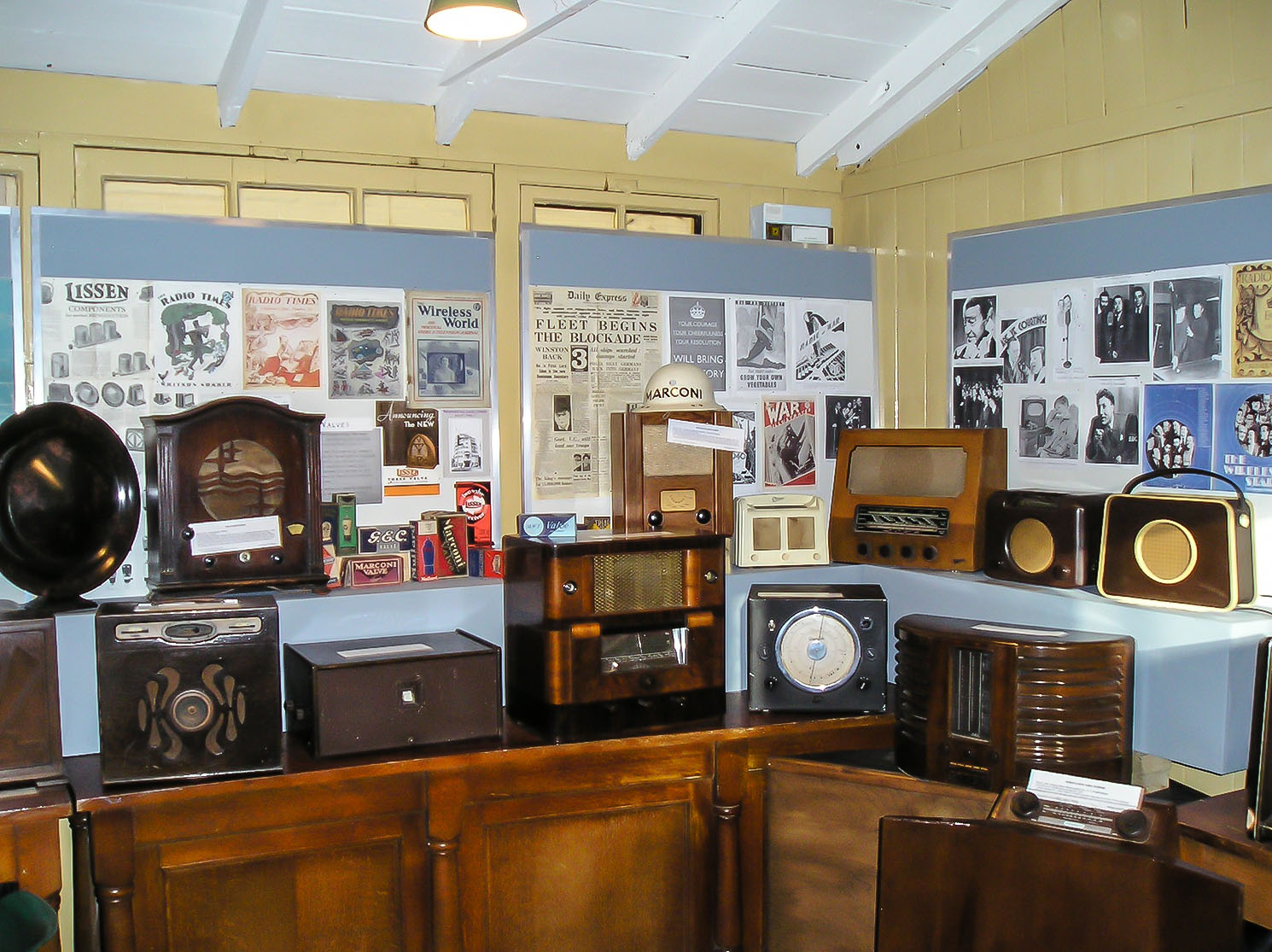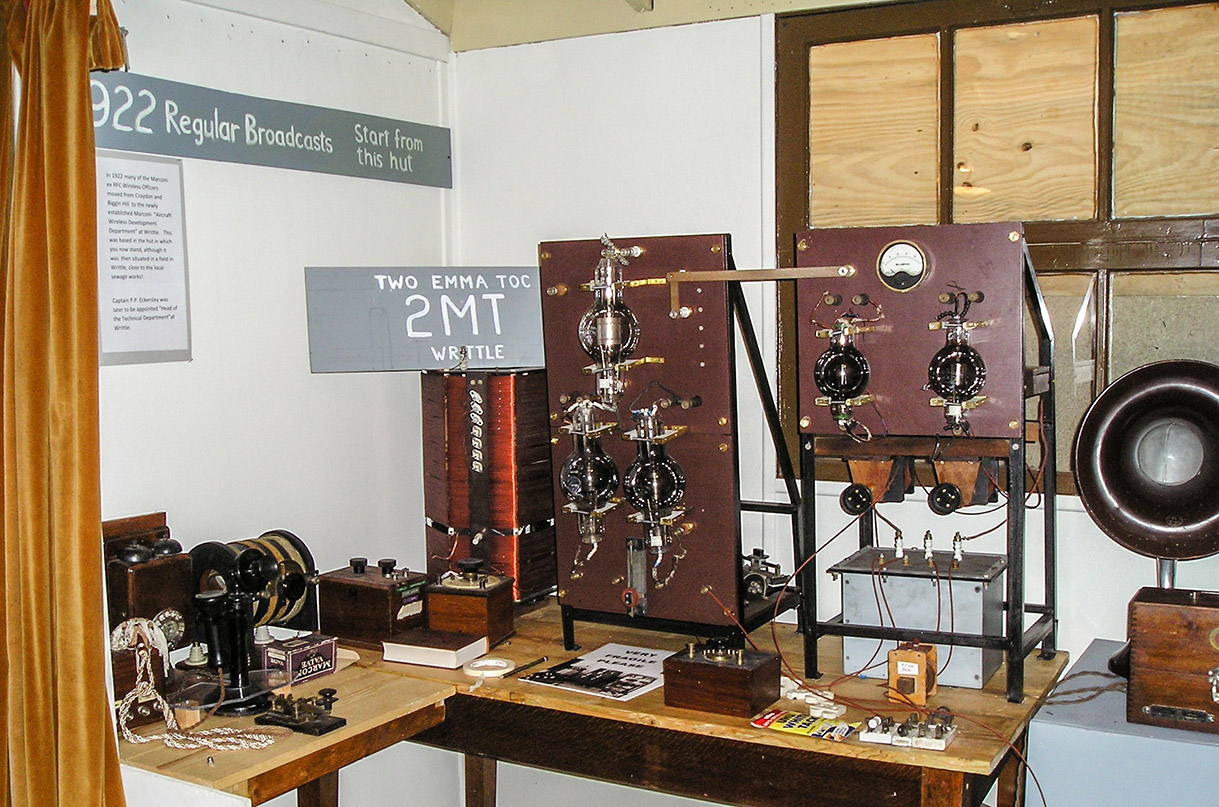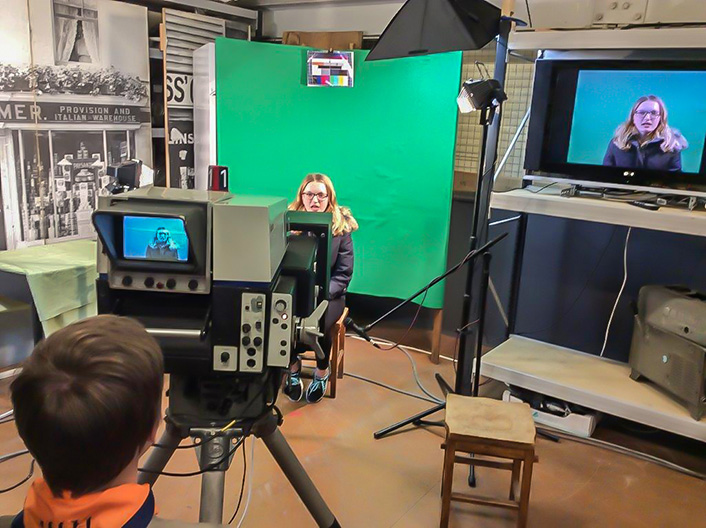
Registered Charity No. 1106243
Enquiries

A display of pre-war radio receivers at Sandford Mill Photographed by Geoffrey Lovegrove

An interactive display in the hut relating to the earliest public broadcasts in this country

A display of TV camera operations at Sandford Mill
The address of Sandford Mill is :- Sandford Mill Road, Chelmsford, CM2 6NY
Sandford Mill was originally a corn mill. The Mill building was constructed of timber and the mill stream ran underneath the centre of the building. The mill stream drove a large water wheel which provided the power for the mill. There were 4 pairs of stones. In 1880, a steam engine was installed to give additional power. Coal for the boiler came from Newcastle and was transported from Heybridge Basin to Sandford Mill by horse drawn barges.
In 1923 Chelmsford Corporation acquired the site for the new Borough Waterworks. Construction work started in 1926 and milling ceased at about the same time. The corn mill was demolished but the two cottages were retained. They were built in 1905 and are the only surviving part of the original mill. The new waterworks started operating in March 1929 although it was not officially opened until July 1930.
A large red brick building was constructed which later became known as the Engine House. Water from the River Chelmer and from a 650 feet ( 200m ) deep borehole on site was both treated and pumped in this building. The water pumps were all electrically driven. The power for these pumps came from diesel powered alternators during the day and from the mains electricity supply during the night. In the early years of the waterworks, some power was also generated by two water turbines, one of 50HP ( 37 KW ) and the other of 26HP ( 19KW ) capacity.
In 1956 the capacity of the waterworks was increased by the construction of the large white building known as the Filter House. Water treatment was transferred from the Engine House to the Filter House and additional pumps were provided in the Engine House. Three small pumphouses were also built to move the water round the site for the various stages of treatment. The treated water was pumped from the Engine House up to Galleywood Reservoir for use in Chelmsford. Two million gallons of water per day were treated and pumped at the works.
The Barn was constructed in the 1960's and was used to store emergency water supply equipment.
In the early 1990's, Chelmsford Museum's activities were being expanded and Sandford Mill was used as a store for industrial artefacts. Then under the guidance of Dr Geoff Bowles and with assistance from the Friends of Chelmsford Museums and others, many of the industrial artefacts were put on display. Educational facilities were added and Sandford Mill then became known as Chelmsford's Industrial Museum and Science Education Centre.
The primary function of museums is the preservation and storage of artefacts but equally important is their contribution to education, in conjunction with schools. This activity was intensely developed at Sandford Mill Science Education Centre where there was hands-on emphasis on science and engineering, but with one unfortunate limitation, the lack of heating. This means that educational activities at the Mill were limited to the period between early spring and late autumn during which time there were two school parties per day.
The Engine House, the Barn and the River Pumphouse have been used for Museum and educational purposes. The remaining buildings and parts of the site are used by other Council Departments.
The Engine House is used to display artefacts from many of Chelmsford's former industries. The largest exhibit is the First World War Army Hut which was used by Marconi engineers for experimental and development work from 1919 until 1960. The first regular radio entertainment broadcasts were made from this hut from 1922 until 1923. The call sign for the broadcasting station was 2MT (Two Emma Toc). The hut contains an interactive display on its unique broadcasting story and it is also used in the teaching Science for Schools teaching sessions. The Engine House also houses the largest collection of Marconi manufactured equipment in the country. There are also displays which include electric motors and generators made by Cromptons, radio valves made by EEV, bearings made by Hoffmanns, iron work made by Christy and Norris and agricultural machinery made in Chelmsford. On the mezzanine floor there is a working Television Studio using old Marconi Television Cameras and other equipment. A manually operated fire pump and old bicycles are also on show. There are also experiments to demonstrate friction and levers. A small outhouse displays many of the blacksmith's tools from the forge at High Easter.
The Barn houses a vintage farm tractor, farm carts and farm machinery, all of which were either made or used in Chelmsford. At the far end of the Barn is a classroom which has been used in the past for the Science for Schools teaching sessions.
Educational programmes at Sandford Mill have now been discontinued and at present there are no plans for further open days.